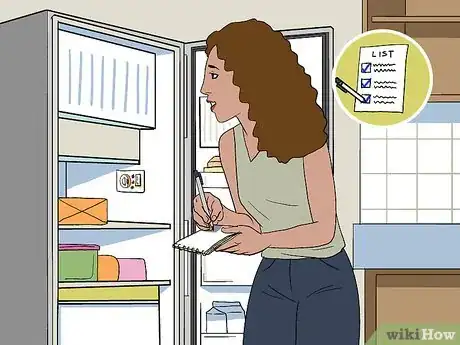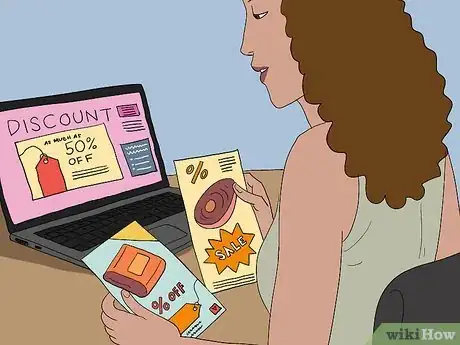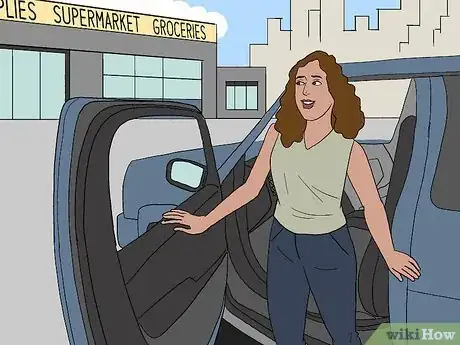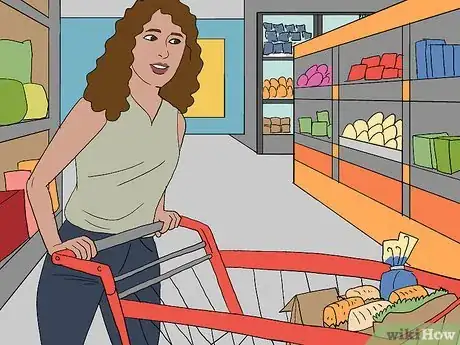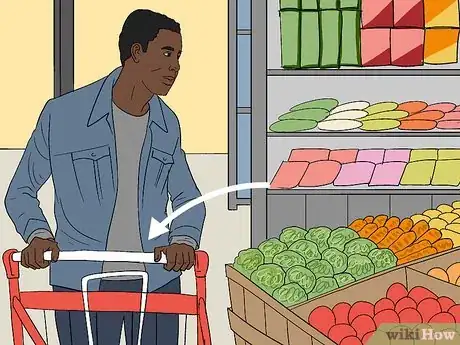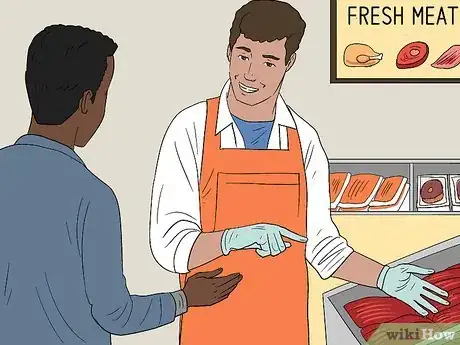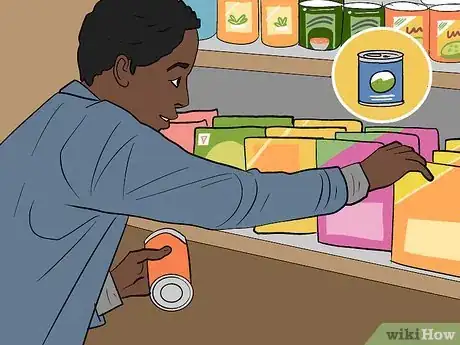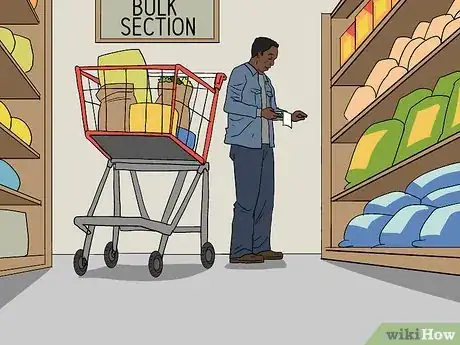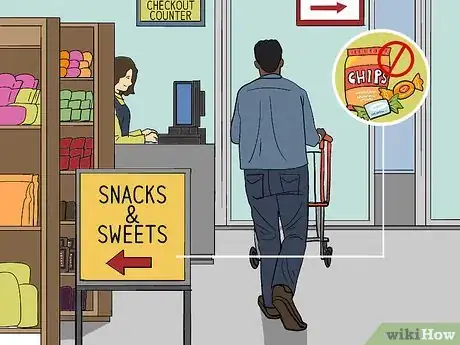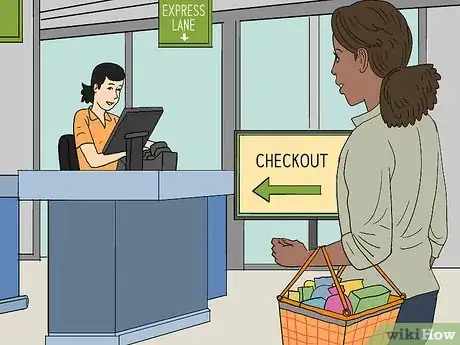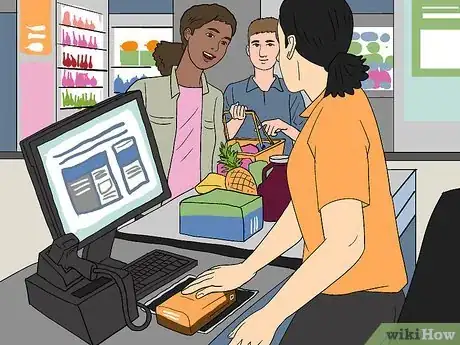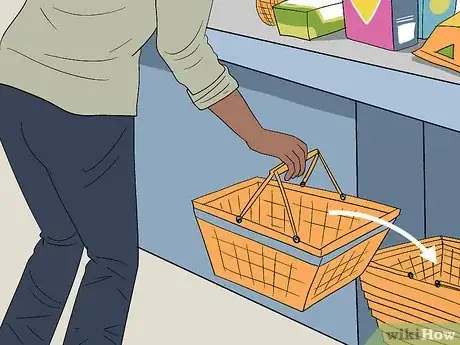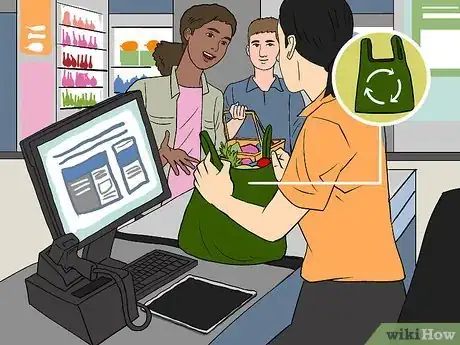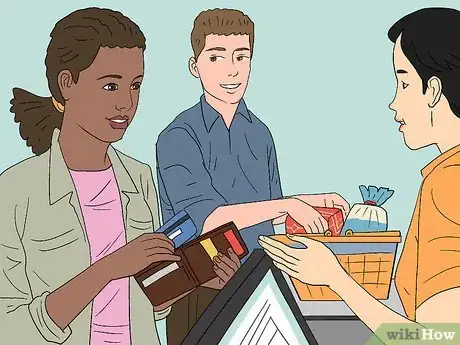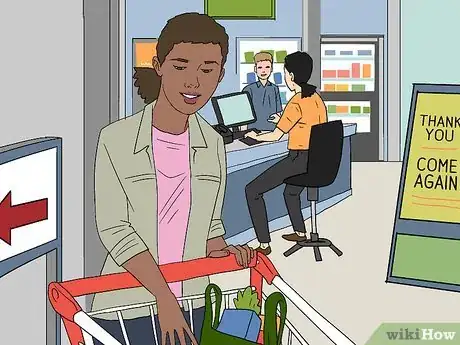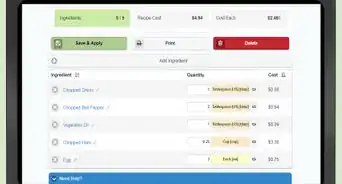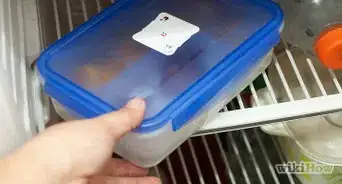This article was co-authored by wikiHow Staff. Our trained team of editors and researchers validate articles for accuracy and comprehensiveness. wikiHow's Content Management Team carefully monitors the work from our editorial staff to ensure that each article is backed by trusted research and meets our high quality standards.
This article has been viewed 203,467 times.
Learn more...
Grocery stores can be large and intimidating, especially if you’ve never been shopping for food before at a store like this. There are lots of people, plenty of aisles, tons of tasty treats to spend money on, and many different departments in a grocery store, so they can be difficult to navigate if you don’t know where you're going. The keys to grocery shopping include being prepared, knowing what you need, buying the right quantities, and looking for ways to save money, especially if you're on a budget.
Steps
Going Shopping
-
1Make a list. The best way to be prepared for your trip to the grocery store is to have a list of all the items you need to buy. That way, you know exactly what you need, can avoid impulse items, and won’t leave the store having forgotten something you need. To make a comprehensive list:[1]
- Go through your cupboards to see what staples you're running low on. This could include flour, sugar, canned goods, rice, spices, tea, and coffee.
- Check your refrigerator to see if you need any fruits, vegetables, juice, or other beverages.
- Create a planned menu for the next week or two. Look over the recipes you'll be making and ensure you have all the necessary ingredients.
- Look through your storage closets and pantries to see if you need any bathroom or facial tissue, soaps, dish detergents, or other household goods.
-
2Check flyers for sales and coupons. If you're looking to save a few dollars at the grocery store, look through store flyers or online for the items that are on sale for the week.
- If you find coupons for any items on your list, clip them out or make a note of the brand that’s on sale.
- If you have a few grocery stores nearby, compare the prices of items listed in the flyers, and make lists of what items you intend to buy at each store to get the best price.
- To avoid spending extra money, only use coupons and flyers for items you were already going to buy.[2]
Advertisement -
3Get to the store. Because you may be buying a large quantity of food, it’s always best if you can take your own vehicle or get a ride to the grocery store. Otherwise, determine a route you can walk or bike, or find what public transit routes will get you to the store you wish to shop at.
- Don’t forget to take your reusable shopping bags with you.
- If you're taking public transit or walking, consider using a rolling cart or large backpack that you can use to transport your groceries back from the store.
-
4Grab a cart or hand basket. When you get to the grocery store, locate a shopping cart (if you need a lot of items) or a hand-basket (if you only need a few items). This will make your shopping experience much easier.
- Shopping carts and baskets are often located near or just inside the doors.
Selecting Food
-
1Place items in your cart or basket as you shop. If you brought reusable bags with you, don’t use them to carry your groceries: most stores prefer that you use the carts or hand-baskets.
- Make sure you don’t crush smaller, delicate, or fresh produce items with larger items as you shop.
- If you're using a cart, use the upper section near the handle for delicate things like fruit and eggs.
-
2Get fresh produce. The produce section is where you'll find all the fresh fruits and vegetables on your list, such as apples, oranges, bananas, lettuce, carrots, and other produce items.
- While each fruit and vegetable has a different indicator of ripeness, you generally want to look for firm fruits and vegetables that aren't bruised, dented, or otherwise damaged.[3]
- Try to buy fruits and vegetables in all colors to ensure you're getting the maximum vitamins and nutrients from your food.
- Remember that fresh produce won’t last as long as frozen, so only buy what you and your family will eat over the next week or so.
-
3Ask for help at the deli, butcher, and seafood counters. If you want to purchase fresh or specialty meat or seafood items, line up at the various counters. Wait your turn in line if there is one, and when it’s your turn, the person behind the counter will ask if you need help.
- Don’t be afraid to ask questions about the products. You can even ask for samples if you aren't sure you'll like something.[4]
- Remember that meat and seafood have short shelf lives if they aren't frozen, so only buy what you'll be able to eat.
-
4Get baked goods from the bakery section. The bakery section is where you'll find items like bread, buns, and baked desserts like pies and cookies. Depending on your grocery store, you may even find fresh pizza dough, bread crumbs, crackers, and other baked goods in this department.
- Sometimes, bakery departments will bake their own bread, and these loaves are often uncut. If you want the loaf sliced, take it to the bakery counter and ask them to slice it.
- Many bakery departments also make fresh cakes that are baked to order, and you can have these customized and decorated for birthdays and other events. Talk to the people behind the bakery counter to find out what services they offer.
-
5Locate grocery items in the aisles. All your dried, canned, and baking goods will be located in the aisles in the center of the store. This includes pasta, rice, sugar, flour, spices, crackers, and cookies, plus canned beans, soups, sauces, vegetables, and other staples.
- When buying canned goods, avoid cans that are dented, punctured, or bulging. Canned goods are great to have on hand, because they last much longer than fresh staples like produce, meat, and bread.[5]
- These center aisles are also where you'll find household items such as toilet paper and dish soap.
-
6Stop by the freezers and refrigerated sections. In the freezers, you'll find frozen meat, prepared foods (such as burgers or meat pies), fruits and vegetables, and side dishes and snacks (such as ice cream and French fries). The refrigerators will hold dairy products, juices, prepared foods, packaged foods, and prepackaged meats.[6]
- Frozen foods like fruits and vegetables that don’t have added ingredients (like salt or oil) are just as nutritious as fresh produce, and they are typically cheaper and will last longer. Just make sure you're going right home, otherwise your frozen items may start to melt![7]
-
7Check out the bulk section. Some grocery stores also have items available in bulk, and this could include spices, candy, snacks, dry goods like grains and pastas, and dried fruits and staples.
- If you take any of these items, make sure you write down the bin number for each item. There will often be white twist ties you can use to seal your bags and write the bin numbers on. Look for pens located near the bags.
- When buying items in bulk, pay attention to the price per weight. Sometimes things will be price per gram, pound, or another unit of measure, and this can add up quickly.
- Some stores will have scales that you can use to weigh your produce or bulk items, and weighing your bags will give you an idea of the final cost of your bulk items.
-
8Try to avoid the junk food aisles. These tend to be located in the very middle of the store, right in the center of all the healthy grocery staples. This is where you'll find pop, chips, candies, and other unhealthy snacks. If you can avoid going down these aisles, the junk food will be out of sight and out of mind, so you won’t be tempted to buy it.
- While it’s ok to indulge once in a while, junk food is not part of a healthy meal plan, and these types of foods tend to be very pricey.
Checking Out
-
1Locate the checkout counter. For convenience, checkout counters are usually located in between entrances or near exits. Each checkout counter will likely have a number above it, and if the number is lit up, that means the lane is open to use.
- Most checkouts usually have express lanes that are reserved for customers who only have a few items. The express lanes will say how many items you can take through that lane. If you have more than the limit, use a regular checkout.
- If you're in a hurry and looking for the quickest line, look for the line with the fewest people, regardless of how many items each person has in their cart. Paying takes longer than ringing items through, so the more people have to pay, the longer checkout will take.[8]
-
2Place your items on the belt. Line up behind the last person in the checkout lane you’ve chosen, but make sure you don’t crowd them with your cart or basket. Move toward the conveyor as the line shortens.
- When space frees up on the conveyor belt, grab a rubber divider from the side of the checkout and place it on the belt to divide your groceries from those of the person ahead of you.
- Start placing your items on the belt, but don’t crowd your food so that things get squished, bruised, or dented. More room will become available to you as the cashier rings through items ahead of you.
- Place large items and boxes on the belt first, and leave delicate items and fresh produce until the end so that it doesn’t get crushed.[9]
-
3Leave hand baskets under the conveyor. Usually, grocery store conveyor belts have an open section underneath at the end of the conveyor (farthest from the cashier) where you can leave your hand basket.
- Once you’ve emptied all your items, place the basket here. If there are others there already, stack yours inside.
- If you're using a cart, however, push it through the line with you as you go.
-
4Provide your reusable bags. If you brought your own bags, now’s the time to use them! Some grocery stores require the customers to bag their own groceries, and in others the cashier will provide this service. .
- If the cashier is bagging the groceries, hand over your reusable bags.
- If you're bagging your own food, place larger items in the bottom and smaller and more delicate items on top.
- Separate raw meats from the rest of your food by putting them in their own dedicated bag.
- If you are buying eggs and loaves of bread, place the carton of eggs in the bottom of one of the bags and carefully place the bread on top. It's a good idea to put this bag in the "seat" of the cart so you know to place it in your car last in a safe place that won't have items placed or fallen on top of it.
- Make sure the cashier rings items through before you bag them.
-
5Provide any points cards and pay. When the cashier has rung through your last item, hand over any points cards you have that apply to that grocery store. This could include loyalty cards for that grocery store or other points you collect.
- Tell the cashier how you intend to pay. This could include with cash, with a debit card, or with a credit card. Give the cashier enough to cover the bill if you're paying with cash, and don’t forget your change. Otherwise, complete the transaction on the machine.
-
6Place your bags in the cart. If you're using a cart, you can place the full grocery bags back in the cart to get them to your vehicle. When you’ve paid, take your receipt and leave the store via the exit.
- Place your groceries into your car if you have one, or find an out-of-the-way spot where you can pull over and put your groceries into your wheeling cart or backpack.
- When you're done, return the cart to one of the outdoor cart corrals located in the parking lot.
References
- ↑ http://lifehacker.com/5935295/i-hate-grocery-shopping-this-is-how-i-fixed-it
- ↑ http://zenhabits.net/50-tips-for-grocery-shopping/
- ↑ http://www.bonappetit.com/test-kitchen/how-to/article/supermarket-101
- ↑ http://www.bonappetit.com/test-kitchen/how-to/article/supermarket-101
- ↑ http://www.bonappetit.com/test-kitchen/how-to/article/supermarket-101
- ↑ https://www.youtube.com/watch?v=u55rQUs_6XQ
- ↑ http://www.bonappetit.com/test-kitchen/how-to/article/supermarket-101
- ↑ http://lifehacker.com/5369876/how-to-choose-the-fastest-line-at-the-market
- ↑ http://lifehacker.com/5935295/i-hate-grocery-shopping-this-is-how-i-fixed-it
Community Q&A
-
QuestionHow long does grocery shopping last?
 Community AnswerDo you mean how long do your groceries last? Fresh vegetables, fruit, dairy, meat and seafood last 3 days, if you put it in your refrigerator as soon as you can after shopping (within 1 hour). Your refrigerator's temperature should be kept below 5 degrees Celsius. Everything else has use-by dates stamped on them, you should read this and throw them out if the date has passed. If you mean how long will you actually be shopping for, that depends on how much you need to buy and whether you're a quick or slow shopper.
Community AnswerDo you mean how long do your groceries last? Fresh vegetables, fruit, dairy, meat and seafood last 3 days, if you put it in your refrigerator as soon as you can after shopping (within 1 hour). Your refrigerator's temperature should be kept below 5 degrees Celsius. Everything else has use-by dates stamped on them, you should read this and throw them out if the date has passed. If you mean how long will you actually be shopping for, that depends on how much you need to buy and whether you're a quick or slow shopper. -
QuestionI am 16. I want to learn exactly what to buy, so that it lasts me a long time, and is also budget friendly, can someone tell me how do determine what items come in most handy for lasting meals?
 Maggie PetersonCommunity AnswerRice and dry beans last a long while and are cheap. Frozen vegetables are typically cheaper and last longer than fresh ones. Invest in some good spices and you can create some good meals with just beans, rice, and frozen veggies.
Maggie PetersonCommunity AnswerRice and dry beans last a long while and are cheap. Frozen vegetables are typically cheaper and last longer than fresh ones. Invest in some good spices and you can create some good meals with just beans, rice, and frozen veggies. -
QuestionI am 12 and my mom sends me shopping on my own all the time. How do I shop without being awkward around others?
 KateyKateCommunity AnswerIt is great that your mom trusts you enough to buy groceries for the family! Make a list to take with you. This will make shopping much easier and less stressful for you. It can be difficult to talk to strangers, but a store employee or cashier could probably answer any questions you might have. It's a tall order for a 12 year old to buy groceries but you just asked all of us for suggestions, that is a pretty good indication that you could ask other questions in the store without feeling awkward!
KateyKateCommunity AnswerIt is great that your mom trusts you enough to buy groceries for the family! Make a list to take with you. This will make shopping much easier and less stressful for you. It can be difficult to talk to strangers, but a store employee or cashier could probably answer any questions you might have. It's a tall order for a 12 year old to buy groceries but you just asked all of us for suggestions, that is a pretty good indication that you could ask other questions in the store without feeling awkward!
About This Article
Before you go grocery shopping, make a list of what you want to buy, and check store flyers for coupons for the items on your list. When you get to the store, look for fresh fruits and vegetables that are firm and ripe, and buy only what you plan to eat over the next week to avoid wasting food. Additionally, ask questions about the quality and freshness of deli and seafood items, and request a sample before you buy if you’re trying something new. As you go through the store, try to put heavier items in one section of your cart, so lighter items don’t get crushed. For tips on how to buy in bulk at the grocery store, scroll down!
